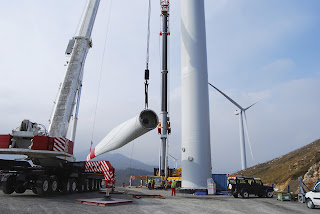 UHPC
Ultra High Performance Concrete has been used for many years in offshore wind
UHPC
Ultra High Performance Concrete has been used for many years in offshore wind- Extremely high strength
- Very good fatigue properties
- Minimal shrinkage
- Extreme bond between UHPC grouting material and steel
- Fast setting development
- Very high inner cohesion
- No mixing with sea water
- Absolutly seawater resistant
- Very low hydration heat
- No corrosion

After the use of UHPC grout in offshore wind energy generation, the experience gained in onshore wind energy production has also been exploited.
Steel Tower
So far, steel towers in cylindrical or conical segment construction have been the state of the art.Depending on the required hub height, up to five segments were mounted on top of each other. With the new tower heights, the segment diameters are getting bigger and bigger and the road transport between production and the site is becoming an ever greater problem.
Concrete Tower
More and more, as an alternative to steel towers, concrete towers are also produced and assembled in cylindrical, conical or polygonal segments. A disadvantage compared to the steel towers is the high wall thickness, which makes larger foundations necessaryThe advantage is
- Favorable vibration characteristics, which leads to reduced noise emissions.
- Long life expectancy
- An ideal solution for high tower high and large rotor diameter
- Transport cost savings due to possible on-site manufacture
- The use of special UHPC concrete grades can lead to slender constructions and thus rougher component weight.
- Lower component weight can also make the foundation dimensioning more favorable, which can lead to cost reduction. The material experiences in the offshore transitionpiece technology can also be of advantage when using UHPC grout in the imbed ring assembly (connection tower / foundation).
- Since UHPC concrete of high quality have virtually no pore formation, they are extremely resistant to corrosion.
- There are little or no maintenance costs.
- The individual segments can be transported more cheaply than is possible with the steel segments.
- On-site fabrication is the use of slipforming is another option including the use of local concrete raw materials for the production of high-quality UHPCs.
- Furthermore, it is possible to produce extremely exact segments with UHPC grout material, which requires no or very little post-processing of the segment abutment surfaces.
- Our UHPC materials reach at least 70% of their rated strength in less than 48 hours, which can lead to lower manufacturing costs for segment production and delivery times can be drastically reduced.
Hybrid towers
This type of tower construction is a combination of concrete (lower part) and steel construction (upper part). IT combines most of the advantages of steel tower and accentuated tower technology. Here, too, the use of UHPC can lead to additional benefits and savings in terms of material and financial resources.
A segment construction or on-site casting by slipforming are possible. This reduces the costs of transport and reduces the foundation geometries.
Phone: 0049 176 601 73146
E-mail: info@wpe-dk.dk
Homepage: www.wpe-dk.com


